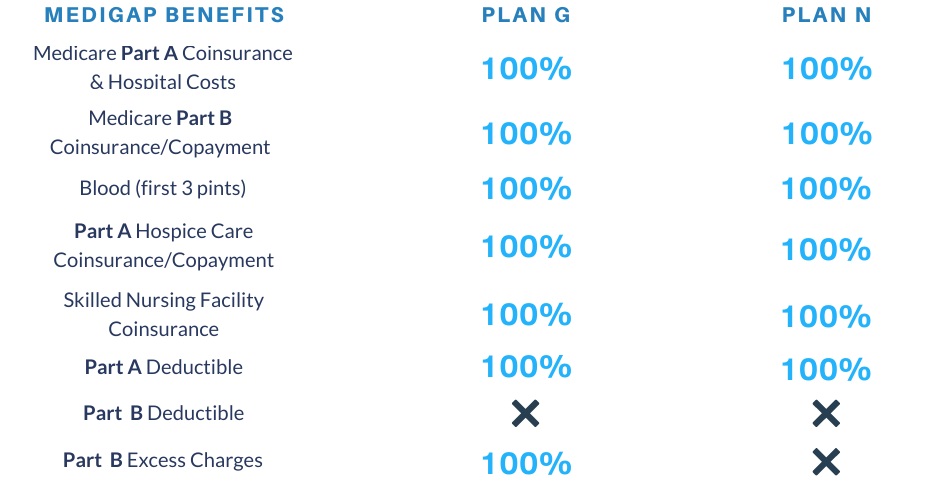There are 10 standardized plans available for Medicare Supplement Insurance (Medigap). These plans are designed to cover healthcare costs that are not included in Original Medicare (Parts A and B). Among these plans, Medigap Plan G and Medigap Plan N are particularly popular due to their extensive coverage and affordability. However, it is important to note that there are differences between the two plans that can impact your healthcare expenses and influence your decision on which plan is more suitable for your needs. In this article, we will compare Medigap Plan G and Medigap Plan N to assist you in making an informed choice.
Medigap Plan G offers extensive coverage and ensures predictable expenses.
Many Medicare beneficiaries choose to purchase additional insurance, such as a Medigap plan, to help cover the healthcare services that Original Medicare does not fully cover. Medigap Plan G is highly regarded for its comprehensive coverage and is a popular choice for individuals looking for extensive financial protection against healthcare expenses.
One notable feature of Medigap Plan G is that it does not include coverage for the Medicare Part B deductible. In simpler terms, Plan G starts paying for your healthcare expenses after Medicare Part A and Part B have made their contributions, except for the Part B deductible.
As of 2024, the Part B deductible amounts to $240. This means that you will need to pay this deductible amount before Medigap Plan G begins covering your Part B expenses for the year. However, once you have paid the deductible, you can enjoy 100% coverage for all approved services between Medicare and Plan G, resulting in predictable and minimal out-of-pocket expenses. For more detailed information on Medicare Plan G, please refer to our various other pages and resources.
what coverage you can expect from Supplement Plan G:
Medicare Part A Deductible:
Plan G provides coverage for the Medicare Part A deductible, which is the amount you would typically have to pay out of pocket before your Medicare benefits start. This deductible is set at $1,632 for the year 2024.
Medicare Part A Coinsurance and Hospital Costs:
With Plan G, you are also covered for Part A copays and coinsurance. Additionally, the plan offers coverage for an additional 365 days of hospital care after your Medicare benefits have been exhausted.
Medicare Part B Coinsurance and Copayments:
As Medicare Part B covers 80% of approved services, Plan G steps in to cover the remaining 20% of Part B coinsurance and copayments. This ensures that you have minimal out-of-pocket expenses for outpatient services such as doctor’s visits.
Blood:
Under Plan G, the first three pints of blood required for a medical procedure are covered. This coverage helps alleviate the financial burden associated with blood transfusions.
Skilled Nursing Facility Care Coinsurance:
If you require skilled nursing care, Plan G will cover the coinsurance for the care received in a skilled nursing facility. This coverage provides peace of mind and financial protection in case you need this type of care.
Medicare Part A Hospice Care Coinsurance or Copayment:
Plan G also covers the coinsurance or copayments associated with hospice care under Medicare Part A. This coverage ensures that you have support and financial assistance during this difficult time.
Medigap Plan N: Affordable Option with Moderate Benefits.
Although Plan G is widely regarded as more extensive, Medigap Plan N provides a cost-effective alternative for individuals who prefer trading a few extra out-of-pocket expenses for a reduced premium.
Below is a comprehensive overview of the coverage provided by Plan N:
Similar to Plan G, Plan N provides coverage for coinsurance, deductibles, and additional hospital expenses under Medicare Part A, as well as hospice care, skilled nursing facility care coinsurance, and the first three pints of blood for a medical procedure. Additionally, Plan N also includes coverage for the remaining Part B coinsurance. However, it is important to note that with Plan N, you will be responsible for some small copayments in addition to the Part B deductible.
Areas not covered by Plan N:
Plan N distinguishes itself from Plan G by having several cost-sharing features. Let’s examine the expenses associated with Plan N:
1. Part B Deductible:
You will need to personally cover the Medicare Part B deductible, which amounts to $240 in 2024.
2. Part B Excess Charges:
Plan N does not provide coverage for Part B excess charges. These charges may arise if your healthcare provider charges more than the approved Medicare amount. In such cases, the provider can impose fees up to 15% higher than the allowed amount, and you will be responsible for paying these additional charges.
3. Outpatient Copays:
Although Plan N offers cost savings through lower monthly premiums compared to Plan G, there are still out-of-pocket expenses when visiting healthcare providers. For specific office visits, you can anticipate a copay of up to $20, and for emergency room visits, copays can reach up to $50.
Nevertheless, many beneficiaries find these costs manageable, especially considering the monthly premium savings, which make Plan N an appealing choice.

Choosing Between Medicare Plan N vs Plan G
All Medigap plans with letter designations are standardized regardless of the insurance company you select. Each plan with a specific letter offers the same medical benefits, regardless of the carrier you choose. This enables you to concentrate on determining the level of coverage that suits your healthcare requirements and financial situation.
Here are a few essential elements to take into account:
Budget-Friendly Option: Opting for Plan N may be a more cost-effective choice if you prefer lower monthly premiums. However, it’s important to note that you will be responsible for sharing some costs when you receive medical services.
Predictable Expenses: If you prioritize predictability in your healthcare expenses and wish to avoid copayments or the Part B deductible, Plan G provides comprehensive coverage with minimal out-of-pocket costs once you meet the Part B deductible.
Protection Against Part B Excess Charges: For complete protection against Part B excess charges, Plan G covers these expenses. However, if you reside in a state that prohibits Part B excess charges, Plan N might be the suitable option for you.
Rate Increases: It’s inevitable for Medigap plans to experience premium increases, but the extent of these changes will vary among different carriers. When selecting a carrier, it is crucial to consider their rate-increase history and financial rating. Choose a carrier that is stable enough to handle claims and one that won’t significantly raise your premium after just one year.
Takeaways
When it comes to choosing the best Medigap plan for you, it ultimately depends on your individual circumstances and preferences. It is important to carefully evaluate your healthcare needs and budget before making a decision.
Both Medigap Plan G and Plan N have their own unique advantages. The choice between the two plans will depend on your financial priorities and healthcare requirements.
If you value comprehensive coverage and want to minimize out-of-pocket expenses, Plan G may be the more suitable option for you. On the other hand, Plan N often offers lower monthly premiums compared to Plan G. If you are comfortable with sharing some costs such as copayments, Plan N may be a more cost-effective choice for you.
 Mario Arce
Mario Arce
I have been working with Medicare clients since 2016. I serve California members in San Bernardino & Riverside county.


